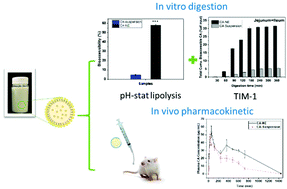Improving the bioaccessibility and bioavailability of carnosic acid using a lecithin-based nanoemulsion: complementary in vitro and in vivo studies†
Abstract
Carnosic acid (CA) represents one of the most effective antioxidants that can be applied for the prevention of degenerative and chronic diseases. However, the intrinsic hydrophobic nature of CA results in low solubility and poor dissolution in the gastrointestinal (GI) tract, which limits its applications in a variety of functional food systems. In order to address these issues, we encapsulated CA in a lecithin-based nanoemulsion (CA-NE) to improve its bioaccessibility and bioavailability which are evaluated using in vitro and in vivo digestion models. The CA-NE demonstrated a loading capacity of 2.6–3.0%, an average particle size of 165 nm, a ζ-potential value of −57.2 mV, and good stability during 4-weeks of storage at 4, 25, and 37 °C. The in vitro static pH-stat lipolysis model and dynamic TNO gastrointestinal (TIM-1) model demonstrated a 12.6 and 5.6 fold increase in the total bioaccessibility of CA encapsulated in nanoemulsion, respectively, as opposed to CA in suspension form. Moreover, the in vivo pharmacokinetics study on a rat model (Male Sprague Dawley) confirmed that the bioavailability of CA in nanoemulsion showed a 2.2 fold increase, as compared to that of CA in suspension form. In conclusion, the bioaccessibility and bioavailability of CA were remarkably improved by encapsulation of CA in a lecithin-based nanoemulsion. Moreover, the combined in vitro and in vivo study could serve as a useful approach for the comprehensive evaluation of oral lipid-based delivery systems.



 Please wait while we load your content...
Please wait while we load your content...